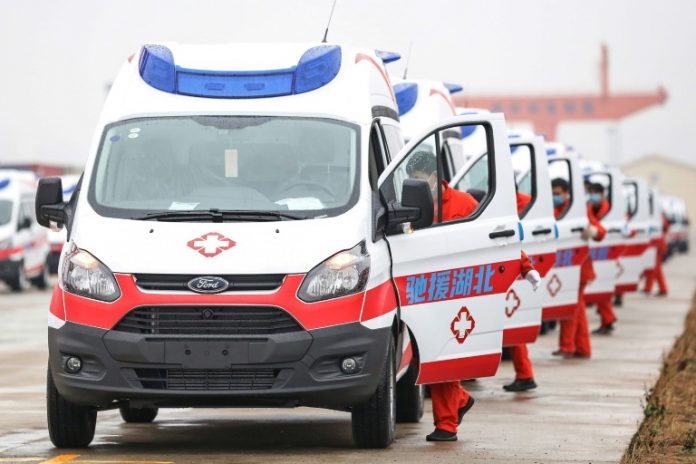China’s official death toll from the new coronavirus spiked dramatically on Thursday after authorities changed their counting methods, fuelling concern the epidemic is far worse than being reported.
As the figures soared in China, a troubling new front opened abroad as neighbouring Vietnam placed 10,000 people under quarantine after six COVID-19 cases were discovered in a cluster of villages – the first such lockdown overseas.
Under criticism at home over the handling of the crisis, China’s Communist Party sacked two top-ranking officials in Hubei province, the epicentre of the outbreak.
The developments came hours after President Xi Jinping claimed “positive results” from efforts to contain an epidemic that has now officially killed 1,367 people and infected nearly 60,000.
But the World Health Organization warned it was too soon to declare victory.
“I think it’s way too early to try to predict the beginning, the middle or the end of this epidemic right now,” said Michael Ryan, head of WHO’s health emergencies programme.
In Hubei and its capital Wuhan, where tens of millions of people are trapped as part of an unprecedented quarantine effort, 242 new deaths were reported on Thursday.
Another 14,840 people were confirmed to be infected in Hubei alone, with the new cases and deaths by far the biggest one-day increases since the crisis began.
Outside Hubei, there were 12 more deaths but the number of new cases fell for a ninth day in a row, with 312 extra patients.
Hubei authorities said the increases were because they had broadened their definition for infection to include people “clinically diagnosed” via lung imaging.
Up until now, they had been documenting cases using a more sophisticated laboratory test.

Health officials said they looked into past suspected cases and revised their diagnoses, suggesting older cases were also included in Thursday’s numbers.
China had been praised by the WHO for its transparent handling of the outbreak, in contrast to the way it concealed the extent of the deadly SARS virus epidemic in 2002-2003.
But it has faced continued scepticism among the global public, with fears that there may be similarities to the way it dealt with SARS.
Authorities in Hubei have been accused of concealing the gravity of the outbreak.
Criticism intensified after the death of a doctor who had tried to raise the alarm about the outbreak in December, but was silenced by authorities.

Analysts said Hubei’s new counting methodology might be a legitimate attempt to be more transparent, but the immediate impact was to sow more distrust.
“Oddly, this now is a moment of greater transparency,” Sam Crane, political science professor at Williams College in Massachusetts, told media.
“It is not clear if the problem up to now, on this issue, was lack of transparency or simply bad medical practice,” Crane said.
Yun Jiang, a China researcher at Australian National University, said the new methodology may be a “practical measure” because Hubei has a shortage of laboratory testing kits.

“I don’t think the numbers are necessarily manipulated for political purposes but the numbers themselves may not be so trustworthy,” Yun told reporters.
On Thursday, the leaders of Hubei and Wuhan were sacked, the highest-profile political casualties of the crisis.
Hubei’s two top health officials were fired earlier this week.
Shanghai mayor Ying Yong took over the top provincial post while an official from eastern Shandong province was appointed in Wuhan.
Both are seen as “Xi’s men” with security backgrounds, said Richard McGregor, senior fellow at the Lowy Institute think tank.
“I guess if the situation in Hubei is a long way from being under control, the party should be worried about instability, because you are literally going to have tens of millions of people confined indoors at least for another month,” he said.
“I think if you are trying to deal with an emergency, you probably want to choose people you can rely on, who are loyal to you.”

In Vietnam, authorities announced they were locking down the commune of Son Loi, a farming region about 40 kilometres (25 miles) from Hanoi, for 20 days.
Checkpoints were set up around the commune, according to reporters in a district on the outskirts of Son Loi.
Health officials wearing protective suits sprayed disinfectant on vehicles.
The biggest cluster of cases outside China is on a cruise ship quarantined off Japan’s coast, where 44 more people tested positive for COVID-19, raising the total number of infections on the Diamond Princess to 218.
Several countries have banned arrivals from China, while major airlines have halted flights to and from the country. Hundreds of people in some two dozen countries are infected.
United Airlines extended its China flight cancellations into late April.
The outbreak has wreaked havoc with global events, with the World Mobile Congress in Spain cancelled and the Hong Kong Rugby Sevens tournament and Formula One Grand Prix in Shanghai postponed.












